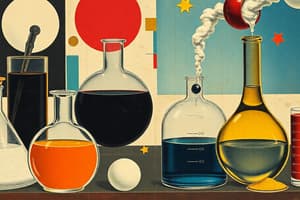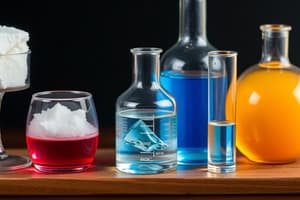Podcast
Questions and Answers
What determines the shape of a solid?
What determines the shape of a solid?
- Intermolecular forces between particles (correct)
- The container it is in
- Its volume
- Temperature and pressure
Which state of matter can undergo continuous deformation?
Which state of matter can undergo continuous deformation?
- Solids
- Liquids (correct)
- Gases
- All of the above
What property do gases exhibit that makes them difficult to contain?
What property do gases exhibit that makes them difficult to contain?
- Fixed volume
- Solid crystalline structure
- Ability to expand into any available space (correct)
- Strong intermolecular forces
Which example is NOT a gas?
Which example is NOT a gas?
What physical process involves a change from a solid to a liquid?
What physical process involves a change from a solid to a liquid?
Which intermolecular force is associated with solids like table salt?
Which intermolecular force is associated with solids like table salt?
What is the approximate shape of liquids due to attractive forces between their particles?
What is the approximate shape of liquids due to attractive forces between their particles?
Which state of matter has the weakest intermolecular forces?
Which state of matter has the weakest intermolecular forces?
What physical process involves a change from a gas to a solid?
What physical process involves a change from a gas to a solid?
Which example is a solid at standard temperature and pressure?
Which example is a solid at standard temperature and pressure?
Flashcards are hidden until you start studying
Study Notes
States of Matter
Although you didn't specify which states of matter you would like information on, I will provide general information about the three most common states of matter: solids, liquids, and gases.
Solids
Solids have a fixed shape and cannot be compressed much without undergoing phase changes. They have strong intermolecular forces between their particles, such as metallic bonding, hydrogen bonding, or van der Waals forces. Examples of solids include table salt, ice, and steel.
Liquids
Liquids have a definite volume but can change shape when in a container and undergo continuous deformation until they have filled said container. They are approximately spherical in shape due to attractive forces between their particles, but these are weaker than those found in solids. Examples of liquids include water, oil, and gasoline.
Gases
Gases have neither a fixed volume nor shape. They expand into any available space and can move freely, which often makes them difficult to contain. Gases show very few attractive intermolecular forces and therefore mostly repulsion. Some examples of gases are air, oxygen, nitrogen, carbon dioxide, methane, etc.
These three states of matter are not static entities. They can change from one state to another through various physical processes like melting, freezing, evaporation, condensation, sublimation, and deposition depending on temperature, pressure, and humidity. For example, when ice starts to melt, it transforms into liquid water because the molecules gain enough energy to overcome the attractive forces holding them together.
The transition between different states of matter depends on specific properties of the substance involved. For instance, water has a unique property known as the triple point where all three states coexist under specific conditions of pressure and temperature.
Studying That Suits You
Use AI to generate personalized quizzes and flashcards to suit your learning preferences.




